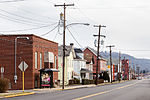Dusmal House

Dusmal House is a historic building in Gastonville, Pennsylvania. It is a three-bay, 2+1⁄2-story house built in 1839. A one-story addition was added later in the nineteenth century. The historic significance of the house is as an example of the Post Colonial style of architecture found in Western Pennsylvania. Vernacular builders mixed elements of Georgian, Roman Classical, Adamesque, and European Renaissance styles as they saw fit, differing from traditions in other parts of the country.In addition to its National Register of Historic Places listing, it is also designated as a historic residential landmark/farmstead by the Washington County History & Landmarks Foundation.
Excerpt from the Wikipedia article Dusmal House (License: CC BY-SA 3.0, Authors, Images).Dusmal House
Finleyville Elrama Road, Union Township
Geographical coordinates (GPS) Address Nearby Places Show on map
Geographical coordinates (GPS)
| Latitude | Longitude |
|---|---|
| N 40.252777777778 ° | E -79.965277777778 ° |
Address
Finleyville Elrama Road 4071
15332 Union Township
Pennsylvania, United States
Open on Google Maps






